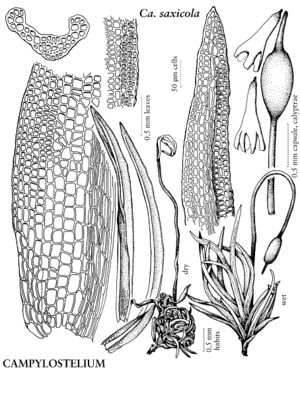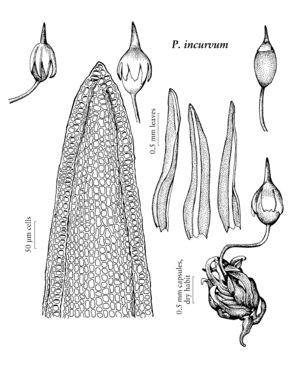Ptychomitriaceae
Plants small to robust, tufted or gregarious or cespitose, yellowish green to blackish. Stems erect or repent, simple or forked; central strand present; rhizoids reddish brown, inconspicuous; axillary hairs several per axil, with 2–3 short proximal cells and 5–7 long distal cells. Leaves erect to crispate or circinate when dry, ascending when wet, linear to oblong-lanceolate; margins entire to coarsely serrate, thickened distally; costa single, strong; medial cells isodiametric, in longitudinal files, 1-stratose, or 2-stratose in patches, smooth or slightly papillose. Specialized asexual reproduction rare, by axillary 1-seriate or branched gemmae. Sexual condition autoicous. Perigonia gemmiform, axillary on short naked stalks. Perichaetia terminal but quickly overtopped by innovations; leaves few, short. Seta single or several from a perichaetium, smooth, straight or flexuous. Capsule erect, exserted, brown, ovoid to cylindric, smooth or wrinkled when dry; stomata scarce, proximal on capsule, phaneropore; annulus revoluble; operculum slenderly rostrate; peristome single, teeth 16, short and broad to long and slender, smooth or densely papillose, mostly irregularly divided into 2–3 slender segments beyond the base. Calyptra mostly mitrate, lobed proximally, often deeply so, naked, smooth or plicate. Spores spheric.
Distribution
Nearly worldwide, mostly in temperate regions.
Discussion
Genera 3, species ca. 80 (2 genera, 6 species in the flora).
The acrocarpous habit, thickened and often serrate leaf margins, smooth or nearly so leaf cells, single peristome, and mitrate, basally lobed, and sometimes plicate calyptra make Ptychomitriaceae recognizable. The family has been included in Grimmiaceae by some authors, e.g., S. P. Churchill (1981), E. Lawton (1971), and A. Noguchi and Z. Iwatsuki (1987+, part 2), but it is recognized as a distinct haplolepideous family by, e.g., H. A. Crum and L. E. Anderson (1981) and D. H. Vitt (1982).
Selected References
None.
Lower Taxa
Illustrations
| Family ⠉ | Taxon | Illustrator ⠉ | |
|---|---|---|---|
 | Ptychomitriaceae | Campylostelium saxicola | Patricia M. Eckel |
 | Ptychomitriaceae | Ptychomitrium gardneri | Patricia M. Eckel |
 | Ptychomitriaceae | Ptychomitrium incurvum | Patricia M. Eckel |
Key
| 1 | Plants delicate, very small; leaves linear above base, entire, commonly circinate when dry; seta flexuous; calyptra smooth. | Campylostelium |
| 1 | Plants coarse, small to robust; leaves acuminate above base, entire to serrulate or serrate, sometimes crispate but not circinate; seta straight; calyptra plicate. | Ptychomitrium |